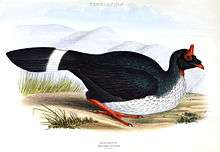Horned guan
The horned guan (Oreophasis derbianus) is a large, approximately 85 cm (33 in) long, turkey-like bird with glossy black dorsal plumage, red legs, a white iris, a yellow bill, and a red horn on top of its head. The breast and upper belly are white, and its long tail feathers are black with a white band near the base. Both sexes are similar. The young are duller with a smaller horn, and have a brown tail and wings.
| Horned guan | |
|---|---|
 | |
| At the Saint Louis Zoological Park | |
| Female Oreophasis derbianus call | |
| Scientific classification | |
| Kingdom: | Animalia |
| Phylum: | Chordata |
| Class: | Aves |
| Order: | Galliformes |
| Family: | Cracidae |
| Subfamily: | Oreophasinae Sclater & Salvin, 1870 |
| Genus: | Oreophasis G.R. Gray, 1844 |
| Species: | O. derbianus |
| Binomial name | |
| Oreophasis derbianus Gray, 1844 | |
The only member species in the monotypic genus Oreophasis, the horned guan is distributed in humid mountain forests of southeastern Mexico (Chiapas) and Guatemala in Central America. It is found at altitudes up to 3,350 m (10,990 ft). Its diet consists mainly of fruits, green leaves, and invertebrates. The female usually lays up to two eggs.

The horned guan is not a true guan, but merely resembles these birds most in overall shape and color, whereas the horn is more reminiscent of the helmeted curassows. In fact, this species is the only survivor of a very ancient lineage of cracids that has been evolving independently from all other living members of this family for at least 20 million years, and possibly as much as 40 million years.
Although it does not have any really close relatives among living cracids, the true guans are apparently most distant. Given that the basal relationships of the living cracids are not well resolved, the horned guan is often placed into a distinct subfamily, the Oreophasinae. Alternatively, it might be included in a large Cracinae with curassows and chachalacas (Pereira et al. 2002).
Due to ongoing habitat loss, small population size, limited range, and hunting in some areas, the horned guan is evaluated as Endangered on the IUCN Red List of Threatened Species. It is listed on Appendix I of CITES.
Taxonomy
The holotype specimen of "Oreophasis Derbianus " G.R. Gray (Gen. Bds., 3, 1844, p.(485).) is held in the collections of National Museums Liverpool at World Museum, with accession number D210. The specimen was collected from Volcán de Fuego, Guatemala by Don Joaquin Quinones circa 1843 and came to the Liverpool national collection via the 13th Earl of Derby’s collection which was bequeathed to the people of Liverpool.
References
- BirdLife International (2013). "Oreophasis derbianus". IUCN Red List of Threatened Species. 2013. Retrieved 26 November 2013.CS1 maint: ref=harv (link)
- Pereira, Sérgio Luiz; Baker, Allan J.& Wajntal, Anita (2002): Combined nuclear and mitochondrial DNA sequences resolve generic relationships within the Cracidae (Galliformes, Aves). Systematic Biology 51(6): 946–958. doi:10.1080/10635150290102519 PMID 12554460 PDF fulltext
External links
- BirdLife Species Factsheet
- Horned Guan photo, Article Aventuras Naturales
- Horned Guan image; Article (Oil paintings)
- Stamps (for Mexico, three types)
- Horned Guan photo gallery VIREO
- Horned Guan videos on the Internet Bird Collection
